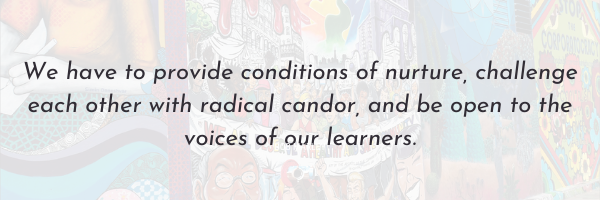As educators, we have committed our lives and careers to schools, colleagues, and students. Despite the obstacles the past few years have left in its wake, we have seen bright spots through teachers who have been creative, resilient, and brilliant, going above and beyond any reasonable job expectations to teach students out of the back of pick-up trucks, on Twitter, and on YouTube.
Despite the effort, intent, and successes in education today, as educators, we have to recognize that we continue to live and teach in a climate of inequity and intolerance. Many adults, claiming to support equal opportunity, stand by policies that create disproportionate outcomes for students and lack the humility to acknowledge that things must change. All students deserve equal opportunities to access a grade-level appropriate, high-quality education. They must believe that their teachers believe in them and cheer for them. They need lessons in humanity, social justice, and equity so they grow with awareness to change the systems that aren’t working for them and their peers.
Our book, Equity by Design, examines the critical pedagogy necessary to transform our systems, our schools, and our world by providing educators with concrete strategies to design and deliver a culturally responsive, sustainable, and equitable education for all students.
As educators, we are expected to implement an educational framework built on the belief that “all means all,” but we are faced with very political and public rhetoric that sends a different message. Our students witness and experience hate, discrimination, marginalization, and apathy based on race, sexual and gender identity, homelessness, language, religion, socioeconomic status, immigration, and disability both inside and outside our schools. Right now, both the Democratic and Republican political parties are engaged in fierce combat for the presidency of the United States of America. Unarmed black men are continuously being victimized by police brutality. Protesters from all walks of life, including professional athletes, are organizing protests, canceling sporting events, holding demonstrations, and taking their messages to social media. All the while, our country is struggling to make sense of how to cope with the impact of the global pandemic and the effects of varying changes in climate.
In order to fight against injustice and inequity, educators in every system need to examine their own implicit bias and create classrooms and schools where all students have equal opportunities to learn, share their voice, and work toward meaningful, authentic, and relevant goals. We have to provide conditions of nurture, challenge each other with radical candor, and be open to the voices of our learners. We need to transform schools and ensure that students and all stakeholders learn to appreciate, value, and respect diversity, embrace their own identities, and take action to make this world a better place. A place where the opportunity to succeed is not a privilege.

Universal Design for Learning is a great way to begin the process because it provides a framework for allowing the options and choices that students need to experience educational opportunities that are fair, just, and equal. Giving your students the opportunity and responsibility of taking charge of their own education, with your guidance, will be a game-changer. Being honest and open with your students while never reducing or eliminating the goals and standards that are expected of them is possible. This will not only change your students' lives but will change your own. Because when we critically examine and work to change, our beliefs, our skills, and our systems, we can have a much more positive impact on the lived experiences of the students and families we serve.
Where do you start?
Begin to have difficult conversations with your colleagues about whom your system serves. Here are five (5) questions that can be framed as a starting point to examine systemic inequality in your school or district (Blake, 2015).
- When decisions are being made, how is “who has a voice” and “who is left out” represented?
- How are “who benefits” and “who suffers” reflected across race, class, gender, and religious lines?
- Who determines if and why a given practice is fair or unfair, and what is their identity and background?
- What is required to create change, and who is responsible?
- What alternatives can we imagine if we reimagine our system? What would change and why?
We have provided a place to begin – but the work does not end. And always remember, as Beverly Daniel Tatum has said, this work is about impact. It is not about intent. We must commit to an ongoing process of examining our impact, addressing our implicit bias, and elevating and celebrating the voices of the learners whom we serve.
Share Article:
Recommended Reading
- Be Honest. Your Vision Statement May Be Out of Reach.
- What are Restorative Practices?
- Using Cogens to Improve Student Experience


